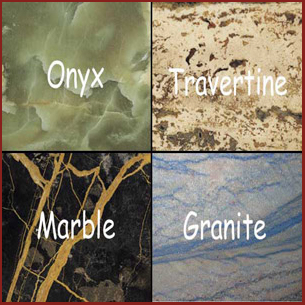Welcome to Blog Post!

Identifying Natural Stone Types
The familiar stone types that are used today are identified through four categories: Sedimentary, Metamorphic, Igneous and Man-made stone.
• I. Sedimentary stone is formed from organic elements such as glaciers, rivers, wind, oceans, and plants. Tiny sedimentary pieces broke off from these elements and accumulated to form rock beds. They were bonded together through millions of years of heat and pressure.
II. Metamorphic stones originate from a natural form of one type of stone to another type through the mixture of heat, pressure, and minerals. The change may be a development of a crystalline formation, a texture change, or a color change.
III. Igneous stones are mainly formed through volcanic material such as magma. Underneath the Earth's surface, liquid magma cooled and solidified. Mineral gases and liquids penetrated into the stone and created new crystalline formations with various colors.
IV. Quartz Stones is a composite material made of crushed stone bound together by an adhesive, (most commonly polymer resin, with some newer versions using cement mix). The two common stones used in producing these products are marble and quartz.
Basalt
Basalt is an igneous rock, basically solidified magna or lava flows. Some basalts are compact; some have small holes caused by volcanic gas bubbles. Basalt is usually dark in colour.
Granite
Granite is an igneous rock composed of quartz, feldspar and mica. It is molten rock that has solidified under pressure. Depending on the mineral content present, it will range in colour from black to brown, pink, green, off-white. A very hard material, it is excellent for worktops.
Limestone
Limestone consists mainly of calcium carbonate that was formed on the bottom of shallow lakes and seas, deposited as loose particles of shells or formed chemically by the action of acidic water containing carbon dioxide. This slightly dissolves the calcium carbonate that is already present, which then reforms by binding onto particles of sand or shell. Over time these beds build up, are duplicated, and become further compacted by the weight and/or pressure caused by movement of the earth¹s crust. Minerals, often oxides of iron, help to decide the various colours of stone available in all shades of white, black, grey, buff and yellow.
Marble
Marble is a metamorphic rock composed mainly of calcite or dolomite crystals. The crystal-like texture is the result of limestone being changed by heat and pressure. Marbles range in colour from white to black, with many varieties of yellow, red, green or beige in between.
Sandstone
Sandstone differs because it is predominantly made up of particles of quartz that have been eroded from other rocks, often granite. These are carried away down streams and rivers until they are eventually deposited. Occasionally they are formed by winds carrying them, like the shifting sands of a desert. Natural cement minerals occur in the ground water and help to glue the particles together. As with limestone, time and the weight of other material on top compacts the sand to form stone.
Slate
Slate is a fine-grained metamorphic rock formed when sedimentary rock, typically shale, is subjected to great pressure. Slate can be split into thin layers. The minerals within the rock re-orientate themselves to be at right angles to the source of the pressure, and so do the planes of easy cleavage. Most slate comes in shades of grey.
Travertine
Travertine is a form of limestone deposited by mineral springs, especially hot springs. It is a hard but holey material (used to build the Colosseum in Rome) and usually exists in a palette of whites, creams and tan.

